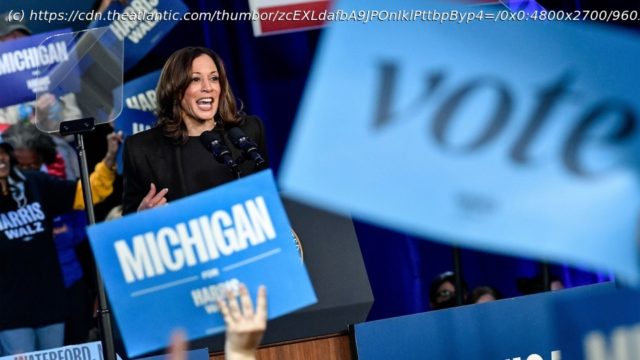The battleground state of Michigan reveals the Democrat’s most plausible path to winning the presidency.
Big margins in the biggest places represent Kamala Harris’s best chance of overcoming Donald Trump’s persistent strength in the decisive swing states. Across those battlegrounds, Harris’s campaign is banking on strong showings both in major urban centers with large minority populations and in the white-collar inner suburbs growing around the cities. Despite widespread dissatisfaction with the economy under President Joe Biden, those are the places where she can find the highest concentrations of voters likely to reject Trump anyway, because they view him as a threat to their rights, their values, and the rule of law.
Posting significant advantages in these large metropolitan areas represents Harris’s best—if not only—opportunity to squeeze past Trump in the most closely contested swing states, particularly the Rust Belt battlegrounds of Michigan, Pennsylvania, and Wisconsin that remain her most likely path to an Electoral College majority.
When Harris visited Michigan last weekend, her itinerary underscored this priority. On Friday night, she appeared before a sizable, enthusiastic audience in Oakland County, a well-educated and prosperous Detroit suburb that has shifted dramatically from red to blue over the past three decades. Then, on Saturday morning, Harris held an event with the singer Lizzo in downtown Detroit on the first day that city residents were eligible to vote early. Yesterday, Harris returned to Oakland County to campaign with former Republican Representative Liz Cheney as part of a day-long sweep by the two women through white-collar suburbs outside Philadelphia and Milwaukee as well.
“That pairing and that geography tells you we think we have a lot of room to run up the score” in those places, Lauren Hitt, a spokesperson for the Harris campaign, told me. Over the weekend, the campaign released strategy memos that cited expanded margins in well-educated suburban communities as the key to Harris’s ability to hold Michigan and Pennsylvania next month. The campaign hasn’t released similar blueprints for the other battleground states, but its formula for victory in all of them looks the same.
Trump is betting heavily on his ability to combine his historical advantage with working-class white voters with improved performance among working-class Black and Latino voters, especially men—and polls show him making progress toward that goal. Harris’s hopes, particularly in the key Rust Belt battlegrounds, depend on preserving enough of her party’s traditional advantage among striving minority voters clustered in the biggest cities, while expanding the Democrats’ edge among the affluent families who step out of their gleaming SUVs at the Whole Foods and Panera stores a few miles away. If Harris is to prevent Trump’s reelection under a more explicitly authoritarian banner, that incongruous electoral alliance among voters whose lives rarely intersect in other ways may represent the last line of defense for American democracy.
Running up the score in the most populous places has underwritten the Democratic advance in virtually all of the states where the party has prospered since the 1990s. Almost by definition, the few remaining swing states in U.S. politics are those whose populations are closely balanced between the Democratic-leaning big cities and inner suburbs and the Republican-leaning small towns and rural communities.
This year, with college-educated voters, especially women, continuing to recoil from Trump, Harris appears on track for strong performances in the large well-educated suburbs around major cities. That’s particularly true in Michigan, Pennsylvania, and Wisconsin, the three states that made Trump president in 2016 when he dislodged them from what I called “the blue wall.” To win those states, much less the Sun Belt battlegrounds where she faces longer odds, Harris will need every vote she can squeeze out of these suburban communities.
Across all the battlegrounds, Trump is pressuring Harris with a powerful pincer movement. From one side, the former president appears poised once again to record towering margins among largely rural, working-class white voters, who are frustrated with higher prices and drawn to his vitriolic attacks on immigrants, elites, and liberals. From the other direction, polls show Trump with an opportunity to make those small but potentially pivotal gains among urban voters of color, particularly men. Harris is unlikely to repel that multifront assault unless she can further improve on Biden’s already significant 2020 margins in the suburbs around major cities from Philadelphia to Phoenix.
These dynamics were at play in Harris’s appearances around the Detroit area last weekend; Trump also appeared in the region last week. When Harris rallied supporters Friday night in Oakland County’s Waterford Township, the fervor of resistance to Trump among the college-educated, professional middle-class voters was fully apparent—even more so than I’d seen in Trump’s earlier campaigns.
The people who were heading into the rally repeatedly reached, unprompted, for the same dire analogy.






